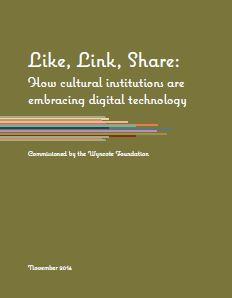
Author: Lutman, Sarah
Publication Year: 2014
Media Type: Report
Summary:
How are cultural institutions using digital technologies to further their missions? What can we learn from talking to innovators doing this work? The Wyncote Foundation commissioned this report to help answer these questions.
Abstract:
"Our inquiry focuses on the universe of “legacy cultural institutions,” defined as decades- or generations-old anchor organizations that have benefitted from substantial public and private investment, that are not founder-led, and that demonstrate enduring value and significance. These include art museums, symphony orchestras, theaters, dance and opera companies, historical societies, libraries, and science centers. We identified a study group of 40 exceptional organizations that have a meaningful digital presence and are viewed as leaders. They were nominated by grantmakers, practitioners, service organizations, journalists, and by asking the nominated organizations themselves. Fortunately, the same cohort of organizations was named again and again, giving us confidence that our study group, while not exhaustive, is a solid one.
While established legacy institutions play a unique and esteemed role in the cultural ecosystem, they also can be viewed less favorably from some vantage points. In their lack of diversity in staff, governing boards, and often in their audiences, they reflect social dynamics that have existed for decades or centuries, including the unequal distribution of resources and access across our communities. By limiting our project to examination of changing dynamics in only these institutions, we did not include the vibrant neighborhood, artistled, and diverse cultural organizations that paint a fuller picture of the vibrancy of the 21st century arts community.
Nonetheless, these generally larger-budget leadership institutions face particular challenges in their systems and relationships that make it difficult for them to nimbly adjust to a changing environment. In pursuing our study, we sought evidence that embracing digital and interactive technologies offers an opening for these institutions to change in ways that make them more relevant, accessible, and connected to communities.
We picked eight organizations to visit, seven non-profits and one public entity. Their characteristics—geographies, sizes, age, endowments, donor bases, and other attributes—differ strikingly. Over the summer of 2014, they willingly shared their stories and experiences with us, generously spending time and allowing access to internal documents and data. What we learned is that despite their differences, these organizations face common obstacles in embracing digital innovation." [Introduction, p. 3-4]
Arts & Intersections: Technology
Categories: Visual Art, Technology and Innovation, Marketing and Communications, Cultural Facilities
ADDITIONAL BIBLIOGRAPHICAL INFORMATION
PUBLISHER INFORMATION
Name: Wyncote Foundation
Website URL: http://www.wyncotefoundation.org/